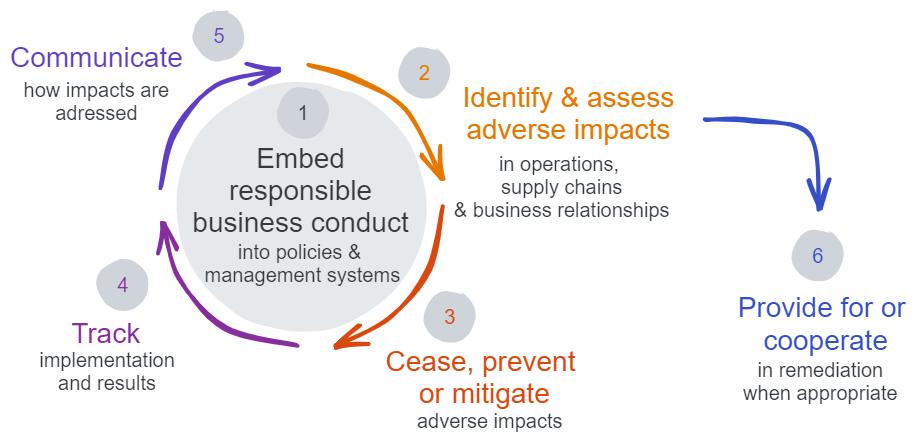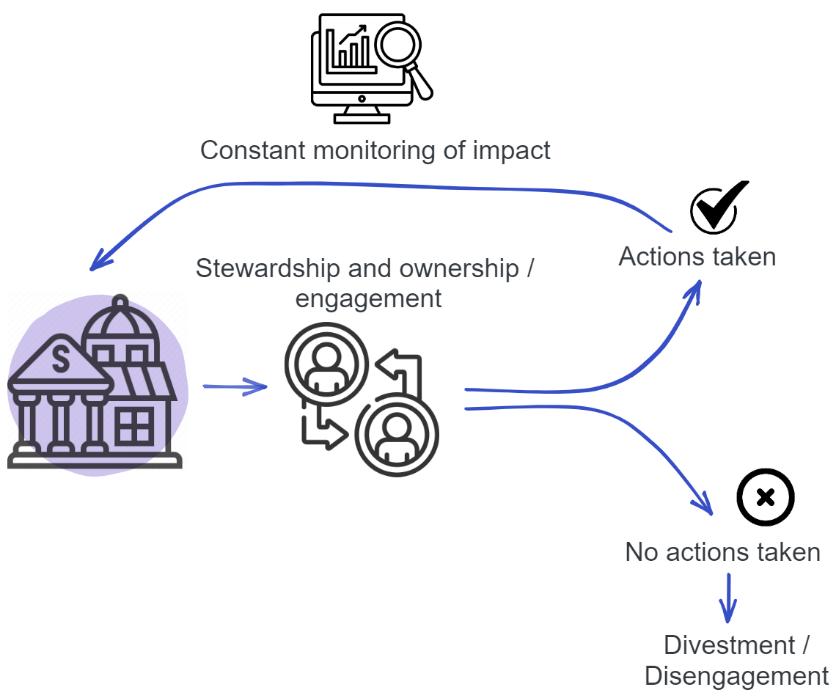
6 minute read
HOW CAN FINANCIAL INSTITUTIONS ADDRESS THEIR ENVIRONMENTAL AND SOCIAL IMPACT THROUGH SUSTAINABILITY DUE DILIGENCE?
Inthischapter,weexplainwhysustainabilityduediligenceis thekeyapproachforfinancialinstitutions(FIs)to systematicallyconsiderimpactsofclientsandinvesteecompaniesandtheirsupplychainonenvironmentaland social issues. We do this by first showing that financial due diligence is a well-established element of financial institutions’ risk management, and consequently the right process for addressing (risks associated with) sustainability impact. We discuss the dynamic growth of voluntary schemes but most importantly the development of mandatory legal frameworks, which is building on the concept of sustainability due diligence
We show how two key steps of conducting sustainability due diligence are aligned with the general risk mitigationstrategiesofFIs.
Advertisement
Ourmainmotivation forthispaper istheongoingnegotiationsofthe CSDDD proposal,which couldmakedue diligencemandatoryforcompaniesandFIs.
DUE DILIGENCE: THE PRIMARY APPROACH TO RISK MITIGATION
Risk mitigation is not a new concept to FIs, it is at the core of their daily decision-making procedures. FIs have to assess and mitigate their financial risk on a continuous basis, to ensure their own and contribute to the financialsystem’sstability.Thecorrespondingprocessiscalledduediligence Therearemultipletypesofdue diligence,buttheprinciplestaysthesame:itconsistsofidentifyingtherisksaninstitutionfaces,analysingand quantifying their severity, taking the necessary measures to mitigate them, and monitoring the success of the mitigationstrategy.ItbasicallyensuresthatFIsareawareofallthedetailsthatmightraiseexposuretorisks;and makefinancingandinvestmentdecisionsaccordingly.
Whilemost typesofduediligence,suchastheassessmentoftheeconomicviabilityofaninvestment(andthe corresponding entity, such as the equity or bond issuer or loan applicant), are part of the standard risk management processes of FIs (and in the sense “voluntary” that they are essential parts of FIs self-interest in understanding the risk/return profile of an investment), FIs also face certain due diligence duties. Prominent examplesaretheobligationstoidentifyandmitigateanyrisksofmoneylaunderingandcorruption. In the financial sector, due diligence is thus the primary approach to risk mitigation. It is a well-established concept which works well for FIs. Due to its wide implementation across different issues, from legal to commercial and financial objectives, it provides a coherent framework and is therefore also an obvious approachtodealwithsustainabilityrisksandaddresssustainabilityimpactscausedbyinvesteecompaniesand activitiestakingplaceintheirsupplychains
SUSTAINABILITY DUE DILIGENCE: A GROWING CONCEPT
Sustainability due diligence works the same way as other types of due diligence explained above, with an importantdifferentiation:itconcernstheenvironmentalandsocialimpactsandtheneedtomitigatethose. As explained in the previous chapter, identifying and mitigating impact of their clients and investees and their supplychainswill,inturn,enableFIstoreducetheirownfinancialrisksaswellastherisksposedtothestability of the financial system. By conducting sustainability due diligence, FIs will be able to better understand the environmental and social harm caused by their investment and financial services and shift their financing to contributetoclosingthesustainableinvestmentgap.
Increasingly, companies and FIs are voluntarily considering negative impacts on sustainability issues, particularly in the fossil fuel industry. Progress is beingmade by FIswho engagewith and support their clients to produce and implement emissions reductions plans 30 The European Central Bank highlighted good practices for environmental risk management, where due diligence appears to be used by some FIs.31 New technical guidelines and frameworks have also recently emerged to help companies and FIs incorporate ESG due diligence in their decision-making, some of which will be referred to below However, more action is required,especiallyinpromotingeffortstopreventthelossofbiodiversityandecosystem
Services
Legislative action to introduce sustainability due diligence is being taken across different constituencies. A few countries in Europe, such as France, Germany and Norway, have adopted, or are proposing, national corporateduediligencelawswithdifferentscopesandobligations 32 Sustainabilityduediligenceisfurthermore necessary to comply with new sustainability-related reporting obligations, as will be explored in more detail below. At the core of many debates right now is the Corporate Sustainability Due Diligence Directive (CSDDD), still under negotiation. Early in December 2022, the European Parliament, European Council and European CommissioncametoanagreementontheRegulationonDeforestation-freeProducts(EUDR). Thoselawsand legislativeproposalsmandateduediligenceforcompaniesandforsomealsoFIs (notwithintheEUDRandstill underdebatefortheCSDDD)andtrytoclarifythestepsrequiredfromthosetargetedentitiesinexercisingdue diligenceonhumanrightsand/orenvironmentalnorms iii
Figure 2 below gives an overview of sustainability due diligence procedure as in the OECD Guidelines and the proposalfortheCSDDDiv Itshowsthe6mainstepstobetaken:
The first step consists of integrating due diligence into internal policies and putting in place a specific due diligencepolicy Step2involvesidentifyingactualorpotentialadverseenvironmentalandhumanrightsimpacts arising from their own operations, those of their subsidiaries and those of their business relationships, where these relate to their value chains The third step is to prevent and mitigate potential adverse impacts, as wellastobringactualadverseimpactstoanendandtominimisetheirextent Thefourthstepconsistsof monitoring the effectiveness of the due diligence actions and the fifth step is to publicly communicate on the duediligenceactions.Lastly,companiesare alsorequired toestablishandmaintainacomplaints mechanism for stakeholders to submit concerns regarding actual or potential adverse impacts, and they must provide remediation,orcooperateintheprovisionofremediation,whereappropriate.
ThefollowingsectionsdivedeeperintoStep2andStep3,potentiallymostcontentiousaspectsofsustainability due diligence. Step 2 is directly related to disclosure framework, while Step 3 is linked to the role of financial institutionsinredirectingfinancingandinvestment.
Step2:Identifyandassessadverseimpacts
The second step requires FIs to be aware of the (potential) impact their financial service causes, directly or indirectly through their investees and clients and their supply chains. For this purpose, disclosures are crucial. In the EU, the Corporate Sustainability Reporting Directive (CSRD) will serve as a reporting framework for sustainability information regarding a wide array of ESG issues. The disclosed information will directly inform companies and FIs under the CSDDD about their own and their clients’ risks and impacts on a variety of ESG iii Thematerialscopeofeachlawdiffersfromoneanother. iv TheCSDDDbasesitsduediligencerequirementsontheduediligenceprincipleintroducedbytheOECDGuidelines,althoughthe orderofstepsslightlydiffers. topics throughout their supply chains and will thus allow them to prevent, mitigate and bring to an end those risksbysheddinglightonwheretheyhappen.
Furthermore,theobligationsarisingfromtheCSDDDwillensurethatmanycompaniesarecoveredbythesame due diligence obligations and communicate their policies and impact publicly. FIs providing financial services tothosecompanieswillthusbeabletomakeuseofthatinformationandtoassesswhetherenoughactionsare beingtakenorwhethertheyshouldengagewiththemmore.Thus,EUlegislationcurrentlybeingelaboratedwill provide a framework for FIs to have easier access to data on value chains impacts and the due diligence processesputinplacebytheirclients.
ForFIstocomplywiththeirduediligencedutiesandinparticulartheidentificationandassessmentofadverse impactsunder“step2”,itwillbeextremelyimportantthatregulatorsaroundtheworld:
(1)swiftlyadoptmandatorysustainabilitydisclosurestandards;
(2)thatthesestandardstakeadoublematerialityapproachtodisclosure,thusobligingcompanies toreportannuallyon:
(a) sustainability risks to the company (from an “outside-in” or financial materiality perspective),and
(b) sustainability impacts by the company (from an “inside-out” or stakeholder/impact materialityperspective) 33
The EU has already adopted respective legislation (the Corporate Sustainability Reporting Directive) and is in theprocessofadoptingthecorrespondingreportingstandards.
Step3:Cease,preventormitigateadverseimpacts
The third step of sustainability due diligence requiresFIstomitigatethepotentialimpact and bring to an end adverse impacts of investee companies or corporate clients and their value chains on ESG factors This correspondstotheprocessesdescribed inthe previous section, stewardship/active ownership/engagement and divestment/ disengagement (as explained, the names varying depending on the type of FI, for example between institutional investors and banks) Due diligence as prescribed by the European Commission’s proposal for the CSDDD is equivalent to a combination of (1) and (2) for both banks and institutional investors Box 2 addresses a few differences between FIs and what this means in terms of the sustainability due diligence process to be conducted. The takeaway is that FIs, even if slightly differing in their risk mitigation practices and ultimate capacity to influence, can still apply the same main elements of due diligence.
Box1:Consequencesofsustainabilityrisk assessmentoncapitaladequacy
One important consequence for banks of identifying and assessing additional (sustainability) risk within their risk assessment processes is the need to increase capital adequacy Capitaladequacyreferstoacertainamountof capital that banks must hold, corresponding to a percentageoftherisk-weightedassets,determinedbythe capitaladequacyratiowhichisdefinedbyregulators.This amountservestoavoidbanksfrombecominginsolventin case risks materialise. By including sustainability issues within their financial risk assessment, the risk-weight will increase due to the proper assessment of reputational, transition and physical risks that sustainability impacts can raise.34 This, in turn, increases the capital adequacy, whichforbanksismoneythattheycannotuseelsewhere. Thiscanrepresentanadditionalcostforbanks.However, due diligence as in the CSDDD and OECD Guidelines wouldrequirebanksandotherFIstopreventandmitigate potential impactandbring toanend actual impact(Step 3).So,therisk-weightoftheassetwillasaresultdecrease andsowillthecapitaladequacy.Therefore,itevenserves FIs’intereststobemoreextensivelyawareoftherisksthat they face through adding sustainability impact in their risks assessment, as well as to conduct due diligence in ordertomitigateandbringtoanendtheimpact,avoiding someliquidityrisksfromhighercapitaladequacy.
While stewardship/engagement and divestment/disengagement are sometimes seen as two distinct strategiesworkingseparately,theyshouldbeseenasmutuallysupportiveandthuscomplementary.
As represented in Figure 3, Engagement and divestment make up a two-step approach. While engagement shouldbethefirststep,to incentiviseandrequireinvesteecompaniestochangetheirbehaviourandbusiness practices (the carrot), divestment serves as a threat in case engagement is not successful and actions are not taken (the stick)35: “divestment, or at least the possibility of divestment, is even a prerequisite for effective engagement, as the absence of the threat of divestment would render engagement toothless”.36 The European Commission also recognises the importance of trying to exercise influence on unsustainable practices before disengagingordivesting.37

Box2: Differentstrategiesforinstitutionalinvestorsandbanks
Regarding the different set-ups of financial institutions, the OECD has already published guidelines per sector, differing between institutional investors,38 banks39 and for project and asset finance transactions.40 In the contextoftheCSDDD,theJURICommitteeoftheEuropeanParliamenthasintroducedanewprovision(Article 8a41)toreflectthespecificcaseofinstitutionalinvestors(seeSection“
Define measures to be taken by institutional investors and asset managers ”) and the European Commission is expectedtoprovidesector-specificguidelinestocomplywiththerequirementsoftheDirective.42 However,the principlesofduediligence staythesameandallkindsofFIsshouldbeabletotaketheabovesixsteps, even if differingintheexactproceduretobeused.
Inthecaseof institutionalinvestors,whiletherearenodirectoperationalor contractualtiesbetweeninvestor and investee companies, the investor can seek to influence the practices of the investee through active ownership, but also by taking and shifting equity stakes. “The approaches investors can employ to use their leverage to influence companies they invest in are broad in scope. These are not limited to direct engagement with investee companies but could also involve, as appropriate, directing capital towards responsible investee companies over time, involvement in industry initiatives targeting certain Responsible Business Conduct risks, collective action on specific geographic or company-specific issues, etc.”43
For banks, their disengagement strategy can differ from other FIs: “Because banks cannot unilaterally stop disbursements or request an early prepayment of a loan unless this is expressly provided for in the financing documentation; disengagement in certain circumstances may involve avoiding additional provision of services to clients in the future.”44
As mentioned earlier, a number of guidelines on how to engage with clients to address impacts happening throughout the supply chain already exist, which the European Commission could build on when elaborating sector-specific guidelines for FIs within the context of the CSDDDv For the specific case of deforestation, examples are the Accountability Framework initiative (AFi)45 and the very recent Deforestation Due Diligence Guidelines for FIs from Global Canopy.46 For example, Global Canopy’s due diligence guidance provides recommendations on best practice actions that FIs can take through engagement, public communication of expectations, exercising stewardship and ownership rights or contractual requirements for the robust implementationofcommitmentstowardsdeforestation 47
Conclusion
Inthissection,wediscussedtheimportanceofconductingduediligencewithregardtosustainabilityimpacts. Due diligence enables FIs to identify the problematic practices of clients and investee companies and put in placetherightframework, including forstewardship/engagement anddivestment/disengagement,toprevent andmitigatepotentialimpacts,andbringtoanendactualimpact SustainabilityduediligencewillallowFIsto reducethefinancialrisksthattheyface,aswellascreatetherightincentivesforandinfluenceoncompaniesto drive change. But why do we the CSDDD for this approach to work? The next chapter describes the key argumentstoconsiderinrelationtomandatorysustainabilityduediligenceprovisions.
v TheUNPRIhasalreadyproducedquiteafewreportsonstewardship,managingESGriskinthesupplychainsofprivatecompanies andassets,activeownership,etc.TheOECD,asexplainedearlier,alsoproducedafewsector-specificguidelines.


